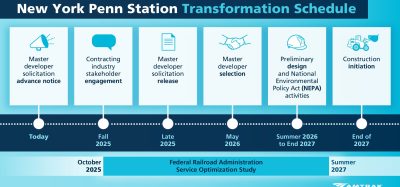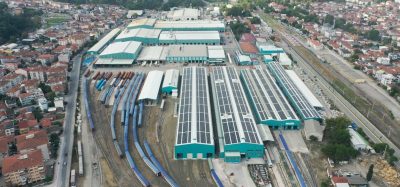Exploring the advantages of 5G for the railway sector
Posted: 6 March 2020 | Kenny Trinh | 2 comments
Ever wondered what 5G will do for technologically advanced transportation systems? Here, Tech-Industry writer, Kenny Trinh, explores the positive impacts of 5G in rail operations.


As worldwide demand to travel by rail continues to grow, today’s current communication systems are unable to provide adequate services to satisfy both passengers and rail operators. Due to the lack of upkeep in communication services, the advent of the 5G network generation is highly sought after in the railway sector. However, is 5G going to be able to offer the railway sector the benefits that they have been longing for? There is much debate and much to discuss regarding replacing the old GSM-R and dedicated systems the railways currently use for signalling.
Making sure that the railway can improve their services, they need novel information and communication solutions that are data-driven to help them. The idea is that these solutions will enable monitoring, exploitation of the energy, and asset information for the entire railway, as well as analysis of various systems. These systems include the power grid, stations, rolling stock, infrastructure and ticket sales.
Monitoring and managing huge amounts of data is very time consuming and taxing on current technology. Therefore, 5G seems to be offering a huge opportunity to improve things for the railway sector.
Technological advantages
5G is offering many technological advances throughout the world in other industries in terms of cellular reliability, so why not apply these advantages to the railway systems as well? Technologically speaking, 5G acts as a consolidator for the entire G range of networks. However, 5G is offering an entire generational shift that allows for 1ms of latency and 1Gbps download speeds, which is a considerable improvement over the former 4G.
5G is cleverly designed so that passengers can be satisfied with download speeds and streaming while travelling by train. However, it is more than that – the technological advances that 5G offers also allows for real-time updates on ticketing and availability, closures, delays, and much more pertinent information a traveller would seek at a moment’s notice. On a deeper level, 5G also helps technicians, conductors, and other railway works to have real-time monitoring of the entire train systems, including areas of wear and tear.
The entire list of technological advances offered by the 5G network is as follows:
- Real-time ticket queue monitoring and availability, as well as dates, times and much more
- Customised marketing strategies towards millions of customers across a vast range of demographics
- Real-time train load rates, availability, and information to help distribute the passengers better
- Wear on the railway infrastructure and monitoring the peak electricity consumption times and distribution
- The possibility of bringing trains to designated depots, only when it is strictly necessary
- Forecasts for traffic through the use of artificial intelligence (AI).
Each of these advances requires a much larger data flow than the current 4G is possibly capable of and cannot commit to.
Advantages for passengers
There are many different advantages that 5G brings to the table for passengers travelling by rail, including:
Join our free webinar: Rail cyber-security in a time of technological and regulatory transformation
Join our expert panel, including speakers from Nokia and Siemens Mobility, to explore the critical convergence of cybersecurity and 5G rail comms.
Date: 3 Dec | Time: 15:00 GMT
Can’t attend live? No worries – register to receive the recording post-event.
- Speed of ticket purchases and readily available tariffs
- Paperless tickets and easy scanning
- Free and reliable Wi-Fi on-board all trains, without interruption.
Pricing is a nightmare for many who enter the jungle of uncertainty. Some elements are only applicable to the local residents and those of certain social statuses’, like students and the elderly. 5G allows for the simplest pricing and the ability to choose from the best formula. You are then sent a QR code, rather than a ticket that needs to be printed.
Through 5G ticketing systems, operators place antennas in train stations for maximum connectivity. However, there are still many black spots along rail tracks that are constantly causing uncertain connectivity with 4G. Many passengers get frustrated, and it becomes an issue. This issue is easily solved with railways implementing the 5G network.


5G is cleverly designed so that passengers can be satisfied with download speeds and streaming while travelling by train.
Advantages for the rail operators
The application of 5G can be grouped into three areas for railway communications:
- Critical environments communications
- Augmented bandwidth with high-speed communications
- Mass communications with the Internet of Things (IoT).
Only two of these areas are most vital to railway communications. The first point, critical environment communications, is very advantageous for maintenance and control applications, and it is also useful for critical operations. Using 5G, the railway can undertake and establish secure and reliable communications that result in super-low latency.
Other areas that will be improved by 5G and rail infrastructure sensor data can be transferred much faster. For example, information such as object recognition, geolocation, train-to-train communications, and trains technical data can all be transferred and shared in seconds. Train depots, and all operators will be up-to-date on the status of any given train on any given day in any given location in a matter of seconds.
The most critical advantage of the 5G network is signalling. The weight of a train and the speed it is travelling determine the space that is necessary between two trains so that they don’t collide. With 5G, there will be improved and more accurate signalling that will avoid the need to spend more infrastructure funds on tracks. The idea is that, through 5G communications, the space between two trains can be reduced and, therefore, improve the rate that they flow together.
However, it is noteworthy to say that not all trains are homogeneous and pose problems that only large amounts of data that are processed quickly can solve. What it does, though, is point out the importance of 5G.
Conclusion
Through the controversial issues that are arising with 5G, there comes out of the railway perimeters a technology and reorganisation of the railway systems that makes it more cost and time efficient. With better communications and improved railway systems, it reduces the overall carbon footprint by encouraging people to choose low-carbon transport more frequently as it continues to offer advanced conveniences.
Implementing 5G to the railway systems is advantageous in many respects. From improved communications to overall operations, the trains will be able to move faster and more reliably, which will help to make choosing the railways an easier option.
Kenny Trinh is a Tech-Industry writer and enthusiast when it comes to modern technology. He built his first desktop at the age of 10 and began coding at 14 years old.
OUT NOW: The Definitive Guide to Rail’s Digital Future
The rail industry is undergoing a digital revolution, and you need to be ready. We have released our latest market report, “Track Insight: Digitalisation.”
This is not just another report; it’s your comprehensive guide to understanding and leveraging the profound technological shifts reshaping our industry. We move beyond the buzzwords to show you the tangible realities of AI, IoT, and advanced data analytics in rail.
Discover how to:
- Optimise operations and maintenance with real-time insights.
- Enhance passenger services through seamless, high-speed connectivity.
- Leverage technologies like LEO satellites to improve safety and efficiency.
Featuring expert analysis from leaders at Nomad Digital, Lucchini RS, Bentley Systems and more, this is a must-read for any rail professional.









In my opinion, 5G is a new technology that will replace 4G. 5G will be a new platform with more capacity than 4G.
Everything has some advantages and some disadvantages, in the same way, 5G technology also has some advantages and some disadvantages. For this, we should also pay attention to its disadvantages. Rest you have told very well about this post 5G technology which will definitely help us in the coming time.